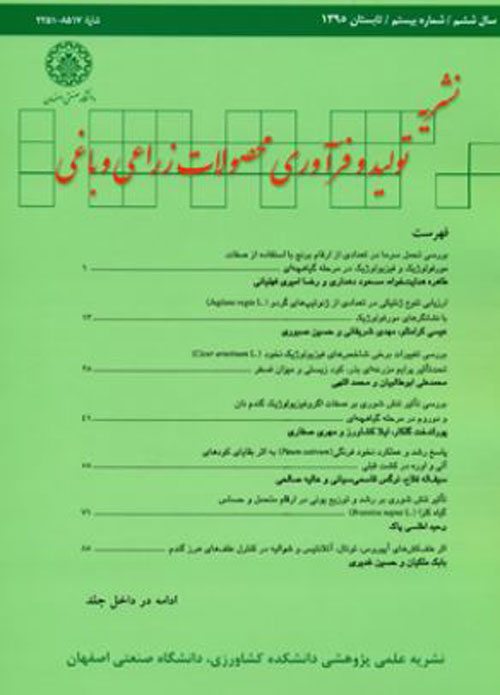Quantity and Quality Evaluation of the Forage in Sorghum- Soybean Additive Intercropping under the Influence of Nitroxin and Phosphate Solubilizing Bacteria Bio-Fertilizers
In order to evaluate the forage quantity and quality of Sorghum in intercropping with soybean, a field experiment was carried out as a factorial based on a randomized complete block design (RCBD) with three replications at the Faculty of Agriculture, University of Maragheh, during the 2016 growing season. The first factor included different planting patterns with eight levels (soybean monocultures with densities of 40 and 50 plants m-2, sorghum monocultures with densities of 10 and 15 plants m-2, and intercropping of the two plant species with the mentioned densities); the second factor consisted of two levels of inoculation with nitroxin (Azotobacter chroococcum and Azospirillum brasilense) Bio-fertilizers and Phosphate solubilizing bacteria (Pseudomonas flurescence) and non-inoculation. The results showed that the highest (25.59 tons ha-1) and lowest total dry forage yield was obtained in intercropping soybean (with densities of 40 and 50 plants m-2) + sorghum (15 plants m-2) with inoculation and soybean monocultures (with densities of 40 and 50 plants m-2) without inoculation, respectively. Also, the highest and lowest values of forage ash, digestible dry matter (DDM) and net energy of lactation (NEL) were obtained in intercropping soybean (50 plants m-2) + sorghum (10 plants m-2) and monoculture of sorghum (15 plants m-2), respectively. The highest content of the acid detergent fiber (ADF) and neutral detergent fiber (NDF) was obtained in the monoculture of sorghum (15 plants m-2) without inoculation. In addition, application of bio-fertilizer increased the content of crude protein (CP), DDM, dry matter intake (DMI) and NEL by 6.29, 1.71, 3.29 and 2.72%, respectively, as compared to the control. Also, the highest land equivalent ratio and monetary advantage intercropping (MAI) were achieved in the intercropping of soybean (50 plants m-2) + sorghum (15 plants m-2). Generally, intercropping of soybean (50 plants m-2) + sorghum (15 plants m-2) and soybean (50 plants m-2) + sorghum (10 plants m-2) could be introduced as the best treatment in terms of forage quantity and quality, respectively.
- حق عضویت دریافتی صرف حمایت از نشریات عضو و نگهداری، تکمیل و توسعه مگیران میشود.
- پرداخت حق اشتراک و دانلود مقالات اجازه بازنشر آن در سایر رسانههای چاپی و دیجیتال را به کاربر نمیدهد.


